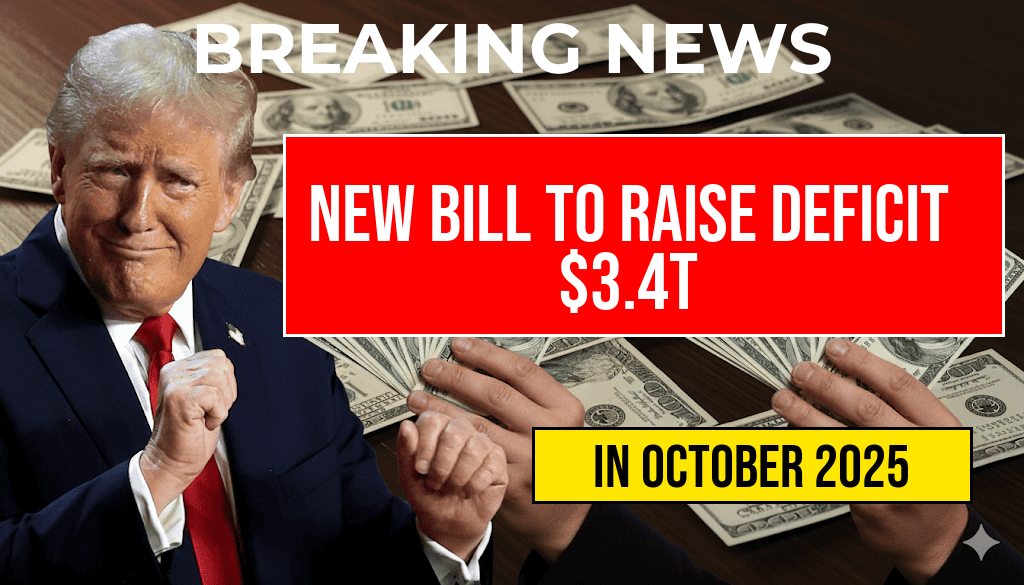Taxpayers across the United States are bracing for significant fiscal repercussions as a newly proposed legislation, referred to as the “One Big Beautiful Bill,” is projected to increase the federal deficit by a staggering $3.4 trillion over the next decade. This bill, which encompasses a wide range of spending initiatives aimed at infrastructure, healthcare, and education, has sparked a heated debate among lawmakers and economists regarding its potential long-term impact on the economy. Critics argue that such a substantial increase in deficit spending could lead to higher taxes and inflation, while proponents claim it will stimulate economic growth and improve public services. With the nation already grappling with a growing debt burden, the implications of this proposed legislation are drawing significant scrutiny.
Details of the Proposed Bill
The “One Big Beautiful Bill” aims to address several key areas of public concern, including:
- Infrastructure Spending: A substantial portion of the budget is allocated for upgrading roads, bridges, and public transportation systems.
- Healthcare Initiatives: Investments in healthcare access and affordability are a central theme, including subsidies for low-income families.
- Education Funding: The bill proposes increased funding for public schools and higher education institutions to enhance educational outcomes.
Projected Economic Impact
Economists have varied opinions on the economic ramifications of the proposed bill. According to a recent report from the Forbes Finance Council, the increase in deficit spending could lead to a short-term boost in economic activity, as government investment typically stimulates job creation and infrastructure development. However, the long-term effects may include rising interest rates and potential crowding out of private investment.
Reactions from Lawmakers
The proposal has elicited strong reactions from both sides of the political aisle. Supporters, primarily from the Democratic Party, argue that the bill is a necessary step toward revitalizing the economy and addressing critical social issues. They emphasize the importance of government intervention in times of economic uncertainty.
On the other hand, Republican lawmakers and some centrist Democrats have voiced concerns regarding the fiscal responsibility of such a massive spending package. Senator John Doe stated, “We must consider the long-term effects of increasing our national debt. This bill could burden future generations with unsustainable debt levels.”
Public Sentiment
Public opinion on the proposed bill appears to be divided. A recent survey conducted by Pew Research Center found that while many Americans support increased spending on infrastructure and healthcare, they are also wary of the potential tax increases required to fund such initiatives. This ambivalence reflects a broader concern about the balance between necessary government spending and fiscal responsibility.
Comparative Analysis of Deficit Spending
| Year | Deficit (in Trillions) | Key Legislation |
|---|---|---|
| 2009 | 1.4 | American Recovery and Reinvestment Act |
| 2020 | 3.1 | Cares Act |
| 2023 | 3.4 (Projected) | One Big Beautiful Bill |
Looking Ahead
As discussions surrounding the “One Big Beautiful Bill” continue, its fate remains uncertain. Lawmakers will need to navigate a complex landscape of economic data, public opinion, and party politics. The ongoing debate will likely shape the future of fiscal policy in the United States and influence the upcoming elections. With many eyes on Capitol Hill, taxpayers are urged to stay informed about the developments surrounding this pivotal piece of legislation.
Frequently Asked Questions
What is the ‘One Big Beautiful Bill’ and how does it affect taxpayers?
The ‘One Big Beautiful Bill’ refers to a proposed piece of legislation that is expected to increase the federal deficit by $3.4 trillion. This bill includes various spending measures that could impact taxpayers by potentially leading to higher taxes in the future to offset the increased deficit.
Why is the bill expected to increase the deficit by such a large amount?
The estimated $3.4 trillion increase in the deficit is primarily due to extensive funding for social programs, infrastructure projects, and other federal expenses that exceed current revenue projections. This level of spending without corresponding revenue increases is a key factor in the anticipated deficit rise.
How might the ‘One Big Beautiful Bill’ impact the economy?
While some proponents argue that the bill could stimulate economic growth through increased spending, critics warn that a larger deficit could lead to higher interest rates and inflation, negatively impacting long-term economic stability and growth.
What are the potential long-term effects of increased deficit spending?
Long-term effects of increased deficit spending may include higher borrowing costs, inflation, and a burden on future taxpayers who may face increased taxes to pay off the debt. This could also limit the government’s ability to invest in other critical areas.
Are there any alternatives to the ‘One Big Beautiful Bill’ that could avoid increasing the deficit?
Alternatives may include targeted spending cuts, revenue increases through tax reforms, or more balanced approaches that prioritize fiscal responsibility. Policymakers may consider these options to achieve goals without significantly increasing the deficit.

Leave a Reply